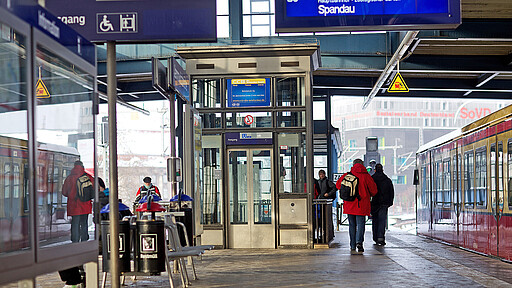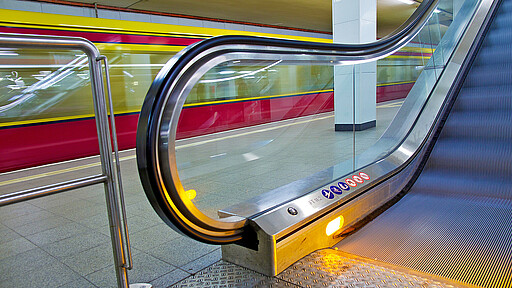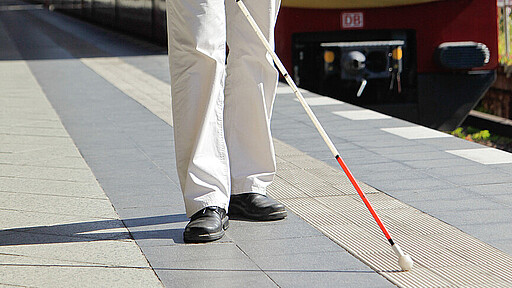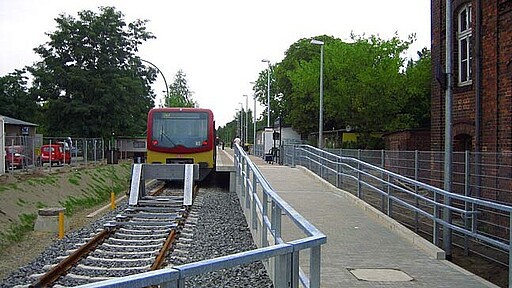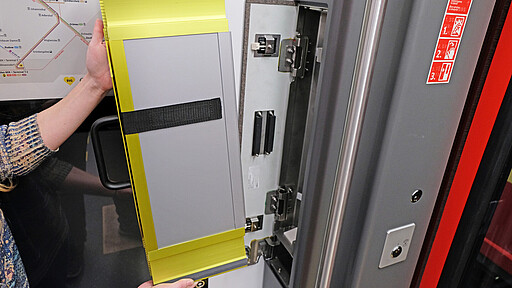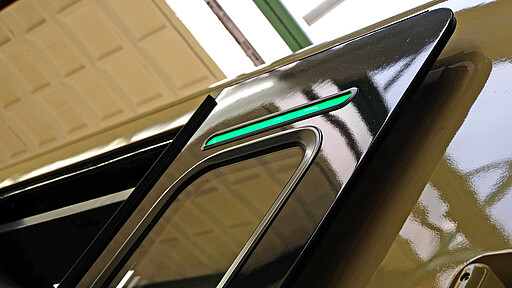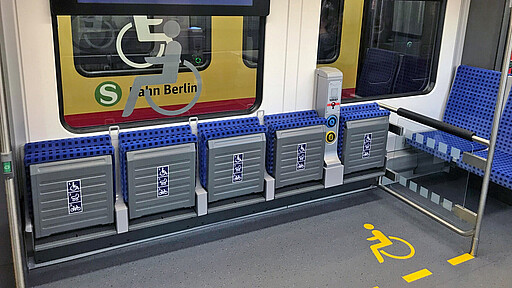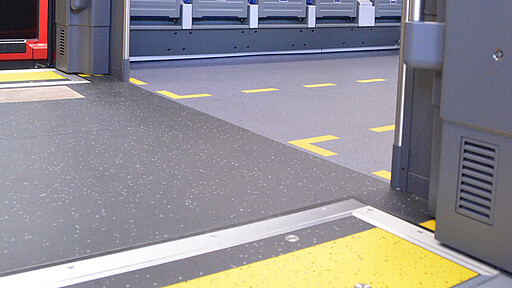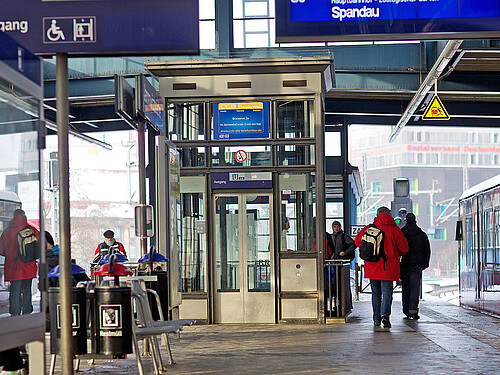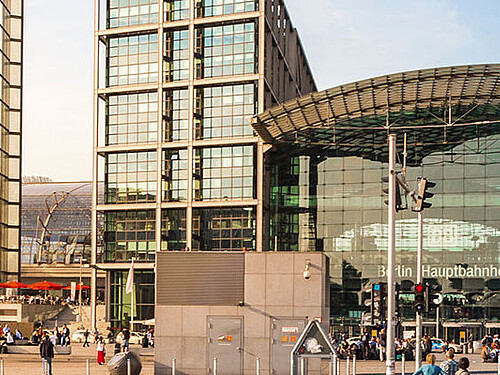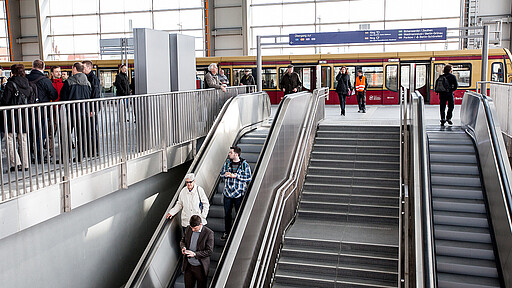Accessible Travel with the S-Bahn
We provide many accessible options for our passengers to move more freely around the stations and in the trains.

- ©
- Hans Friedrich
Whether it be elevators, escalators, ramps, signs, or guide systems for the blind – accessibility at all stations is a long-term goal at the S-Bahn Berlin.
90 percent of all S-Bahn stations in Berlin and the surrounding regions are accessible.
Accessibility is not just about elevators. S-Bahn stations are considered barrier-free when
- platforms are equipped with elevators or ramps (with railings and landings) and
- tactile paving; and when
- destination display boards, timetables, and signs are at a wheelchair accessible height.
- Elevators must also have sufficient space and buttons with braille or automated announcements upon arriving at each floor.
Mobility Assistance at the Stations
- 161 stations of the 168 S-Bahn stations in Berlin and Brandenburg are already barrier-free due to their ground-floor location, ramps and/or elevators.1 2
- The platforms of 145 stations are equipped with guide systems for the blind.
- 106 stations in Berlin have Braille handrails on the stairs.2
- There are 238 lifts at the stations.
- 262 escalators can be found in total at the stations.
1 Without lifts: Karl-Bonhoeffer-Nervenklinik, Yorckstraße S2, S25, S26 platform, Nöldnerplatz, Marienfelde, Hirschgarten, Schönfließ and Eichwalde
2 Status: December 2024, rest of the figures older
Additional Services
- VBB Bus & Train Guide Service (a free service that assists passengers from their front door to their destination and back)
- BVG Muva lift substitute (alternative, barrier-free travel option, only valid for S- and U-Bahn stations and bus stops in the tariff zone Berlin AB)
- "WirMobil" (on-call taxi for people with disabilities [for private journeys only], which can also transport electric wheelchairs)
- Berlin for the Blind (an audio guide for Berlin visitors who are blind and/or visually impaired)
- Mobidat mobility for all (an online accessibility database for Berlin institutions)
Plan your journey online
In our online journey planner, you have the option of searching directly for accessible routes by selecting a suitable profile for your search. To do this, click on the item "Travel with disabled access" under "extented search options" (gear icon) after entering your starting point and destination:
- Profile: "Barrier free access": A route is searched for on which ramps and lifts are available throughout.
- Profile: "Limited access": There may also be escalators and steps on your route, but no stairs.
- Profile: "Not barrier-free": There may be stairs on your route.
Furthermore, you can exclude certain stations as transfer points ("avoid changes").
Elevators and escalators that are currently out of order also appear in your search results if you have selected the profile "Conditionally barrier-free" or "Fully barrier-free".
Barrierefreie Bauinformationen
On our Youtube channel you will find accessible construction information on our major construction projects with sign language and subtitles (available only in German!)
Elevators and Escalators
Escalators and elevators serve as entry and exit assistance between the platform and entrance area. Current disruptions can be viewed here, sorted by station:
To the Elevator/Escalator Outages
For stations in the tariff zone Berlin AB, there is also the option of using an BVG Muva on-call taxi at no extra cost to the ticket, e.g. as a lift substitute, if a bus line is overcrowded or the walk is too long.
Guide System for the Blind
More and more train stations are implementing guide systems for the blind in order to offer better service to our visually impaired passengers. The guide system on the platforms consists of oblique and longitudinal tactile paving (ribbed plates). Special signs point out exits (stairs, elevators, ramps) and on some platforms, painted guide strips run along the raised strips.
Braille and prismatic lettering (raised lettering) can be found on handrails, elevators, and vending machines. Braille is a system of raised dots that can be read with the fingers by the visually impaired.
Ramps
There are ramps at many stations, they provide smooth accessibility between the platform and entrance area.
The S-Bahn platforms are also equipped with portable ramps that can be used to bridge the distance between the train and the platform if necessary. The ramps are fitted by local staff or the train driver to ensure safe boarding and alighting for wheelchair users.
Our new S-Bahn also has a folding wheelchair ramp directly behind the driver's cab in the first carriage.
Visual and Acoustic Signals
Visual signals, mounted above the doors, flash warning lights and sound when the S-Bahn doors close. These acoustic and optical signals serve as a guide for the hearing impaired or deaf, as well as the visually impaired or blind passengers.
On the new S-Bahn, black-painted doors make orientation easier for people with visual impairments.
Assistance getting off or on the train
If you would like assistance entering or exiting the train, please use the first doors at the front of the S-Bahn so our staff can assist you. It is also helpful to use hand signals to draw attention to yourself.
To know exactly where the train stops, passengers should pay attention to the signs on the platforms. These include, for example, the blue signs with the words "Kurzzug Anfang" (short train start). In addition, the electronic train destination boards display information about the length of the train and approximately where it will stop on the platform.
In our oldest series 480 (currently only on the S3), the entrance for wheelchair users is at the end of the first carriage (third door).
Mobility Assistance on trains
All trains have passenger cars with spacious sections (Mehrzweckabteile) that cater to passengers with wheelchairs, bikes, and strollers. In the new S-Bahn, service units in the multi-purpose areas enable wheelchair users in particular to communicate better when needed.
In the door areas of the new S-Bahn, the floor is also darker in colour to make it easier for people with impaired vision to find their way around.
Service unit inside the new multi-purpose compartment
The service units inside the multi-purpose compartment combine several functions designed for improved communications, especially for wheelchair users.
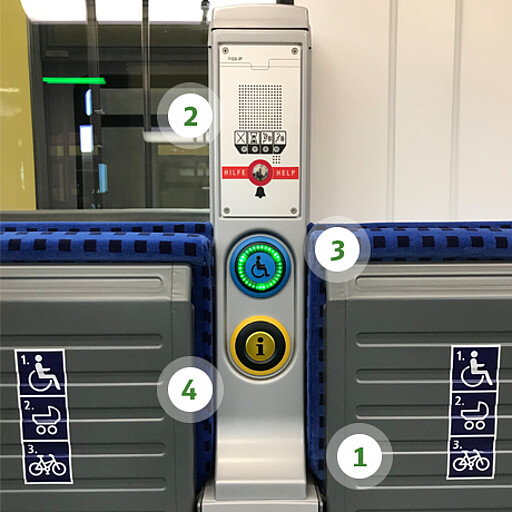
- ©
- Sandra Wiedemann
- Service column: installed between the folding chairs of the multi-purpose compartment for easy wheelchair access
- Intercom: to contact the security control centre and transmit CCTV footage of the carriage in case of emergency
- Blue button: to request wheelchair assistance on exiting the train (wheelchair ramp), also extends door opening times at the front of the train
- Yellow button: to establish voice communications with the S-Bahn service centre in case of questions or to report that the carriage requires cleaning
